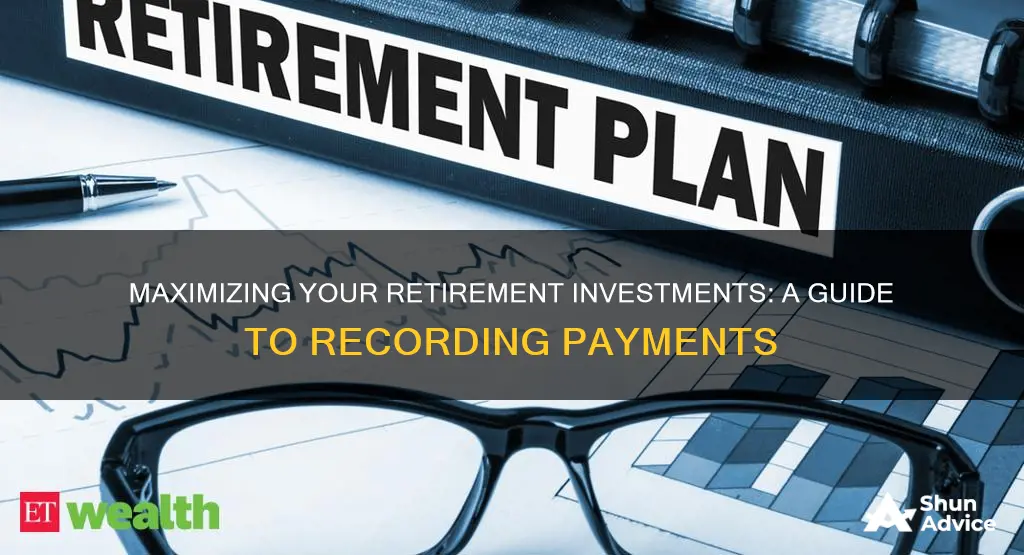
Keeping track of your retirement investments is essential, and there are a number of ways to record payments. Firstly, it is important to keep hard copies of key investment records, even if you have chosen to go paperless with a financial institution. This includes trade confirmations, account statements, and IRS Form 1099 tax records. These documents provide important information such as taxable interest, dividends, and distributions. Additionally, as a plan sponsor, you are required by law to maintain certain records, such as the plan and trust document, determination and approval letters, and participant records. These records vary depending on the type of retirement plan, such as SEP Plans, SIMPLE IRA plans, or profit-sharing plans. It is also crucial to keep records for tax purposes, including federal and state tax returns, IRA and 401(k) plan documents, and transaction records. Proper record-keeping ensures that you have the necessary information when filing tax returns and can provide proof of your investments if needed.
What You'll Learn

Keep hard copies of key investment records
Keeping hard copies of key investment records is a good idea, even in today's paperless world. This may mean printing out records yourself if you have gone paperless with your financial institution. Keeping hard copies ensures you have important information on hand when you need it, such as when you file tax returns. It also means that if something goes wrong with your account, or you have a problem with your brokerage firm, you have proof of the investments you made, when you made them, and how much you invested.
You should keep hard copies of end-of-year summary account statements, as well as statements from retirement savings plans. Keep copies of your annual IRS Form 1099s, which show dividends, interest, and capital gains from your investments. Keep transaction records confirming the purchase or sale of stocks, bonds, and other investments, as your brokerage firm is not required to keep these indefinitely. Keep these for at least three years after you've sold an investment.
It is also important to keep hard copies of your federal and state tax returns, along with supporting documentation, going back seven years. Keep copies of your IRA and 401(k) plan documents, as your beneficiaries will need this information to determine how to take distributions from your account after your death.
Long-term storage is particularly important for tax records, which are often affected by your investments' performance. Although the Internal Revenue Service can normally audit your income tax returns for three years, it can investigate your tax records for up to seven years. It's also important to keep any records of purchase for as long as you hold an investment.
When you do discard investment records, be sure to destroy them with a shredding machine to avoid identity theft. Shredding is especially important for any records bearing your account numbers and personal identification numbers.
Smart Places to Invest $3K Today
You may want to see also

File your taxes for free
Keeping good records of your transactions, statements, and other account information is essential when it comes to investing for retirement. This includes trade confirmations, account statements, and IRS Form 1099 tax records, which report taxable interest, dividends, and distributions. Even in today's paperless world, keeping hard copies of key investment records is recommended.
When it comes to filing your taxes, there are several options available to do so for free:
IRS Free File Program
The IRS Free File Program is a partnership between the IRS and tax preparation software companies. It provides two ways for taxpayers to prepare and file their federal income tax online for free:
- Guided Tax Software: This option is available for taxpayers with an adjusted gross income (AGI) of $79,000 or less. It offers free online tax preparation and filing at an IRS partner site, with accurate math calculations guaranteed. Some trusted partners also offer free state tax preparation and filing.
- Free File Fillable Forms: These are electronic federal tax forms, equivalent to a paper 1040 form. This option is for taxpayers with an AGI greater than $79,000 and requires you to know how to prepare your own tax return using form instructions and IRS publications if needed.
To use the IRS Free File Program, you must begin by visiting IRS.gov and choosing an IRS Free File option. You will then be directed to the IRS partner's website to create an account and prepare and e-file your federal tax return. Once your return is accepted by the IRS, you will receive an email notification.
H&R Block Free Online
H&R Block offers a free online tax filing service that includes tax forms for the Child Tax Credit (CTC) and Earned Income Tax Credit (EITC). You can take a picture of your documents with your phone, and the app will also allow you to watch your refund update in real time.
Other Options
- File an extension: Regardless of your income, you can file an extension with an IRS Free File partner. You must estimate and pay the tax you owe by the April deadline.
- Direct Pay: You can use Direct Pay to pay your individual tax bill or estimated tax payment from your bank account for free.
Invest in Us: The Human Advantage
You may want to see also

Keep plan and trust documents
Retirement plan records are important and should be kept until the trust or IRA has paid out all benefits and enough time has passed that the plan won't be audited. As a plan sponsor, you are required by law to keep your books and records available for review by the IRS. These records will also help answer questions when determining participants' benefits.
Plan records may cover many years of transactions, and the Internal Revenue Code, Income Tax Regulations, and the Employee Retirement Income Security Act of 1974 (ERISA), as amended, require plan sponsors to keep records of these transactions as they may become material in administering pension law. You should be prepared to provide complete and accurate records in either paper or electronic format if the IRS requests them during an audit.
As a plan sponsor, you should keep the plan and trust documents, recent amendments, determination and approval letters, related annuity contracts, and collective bargaining agreements. The specific records you keep depend on the type of plan you sponsor. For example, for profit-sharing, 401(k), or defined-benefit plans, you should keep your plan document, adoption agreement (if you have one), and all plan amendments.
Trust records include investment statements, balance sheets, and income statements. Participant records include census data, account balances, contributions and earnings, loan documents and information, compensation data, and participant statements and notices.
Fear of Losing Money: Why People Don't Invest
You may want to see also

Know your cost basis
Knowing your cost basis is critical to understanding whether your investments are profitable and how they will be taxed. Cost basis refers to the original value or purchase price of an asset or investment, which is used to calculate capital gains or losses. This is the difference between the selling and purchase prices of capital assets.
When you sell or exchange shares of a mutual fund in a taxable account, you must report the transaction to the Internal Revenue Service (IRS). To determine whether you have made a gain or loss, you must first know your cost basis. This is calculated by taking the original price paid for the shares, plus or minus certain adjustments required by applicable tax rules, such as adjustments for reinvested distributions and sales charges.
For example, if you bought 10 shares of a company for a total investment of $1,000 plus a $10 trading fee, and then received dividends of $200 in year one and $400 in year two, your cost basis would be $1,610. If you then sold the stock in year three for $2,000, you would have made a taxable gain of $390.
It is important to note that the cost basis may change over time due to financial and corporate developments, such as stock splits, dividends, and return of capital distributions. Additionally, the cost basis for capital assets like real estate can be adjusted based on the price of any capital improvements or casualty loss amounts.
Most brokerages offer cost basis tracking and will report any necessary gains and losses to the IRS on Form 1099-B. While the default method for determining cost basis is First In, First Out (FIFO), there are other methods, such as specific share identification, where the investor identifies which shares were sold.
In the context of retirement accounts, like IRAs, cost basis plays a more limited role. This is because IRA contributions are typically deductible at the time they are made, so when the accountholder starts taking distributions in retirement, the full amount of each distribution is subject to tax. Similarly, Roth IRAs do not offer an upfront tax break, but as long as certain rules are followed, withdrawals in retirement are tax-free, regardless of the appreciation in value of the investments.
However, there are a couple of exceptions where cost basis can be important for IRAs. The first is when nondeductible contributions to a traditional IRA are larger than the total value of the account, in which case the resulting loss can be claimed on your tax return. The second exception involves distributions from Roth IRAs that do not meet the qualification rules for tax-free treatment. In this case, even if a distribution violates certain rules, you can still withdraw up to the total amount of your contributions without tax penalties.
LLCs: Why Investors Are Wary
You may want to see also

Check state tax rules on pension income
The tax rules on pension income vary across different states. While some states do not tax pension payments, others do. Notably, states cannot tax pension money you earned within their borders if you've moved your legal residence to another state. For example, if you worked in Minnesota but now live in Florida, which has no state income tax, you don't owe any Minnesota income tax on the pension you receive from your former employer.
- Alabama
- Alaska
- Florida
- Illinois
- Mississippi
- Nevada
- New Hampshire
- Pennsylvania
- South Dakota
- Tennessee
- Texas
- Washington
- Wyoming
Some states offer a pension exclusion that allows taxpayers over a certain age to deduct a certain amount of their pension income from their taxable income. For example, Delaware offers a pension exclusion that allows taxpayers aged 60 and older to deduct up to $12,500 of qualified retirement plans from their taxable income.
Additionally, some states have a retirement income exclusion. For instance, Georgia taxpayers aged 62 and older may exclude up to $35,000 of their retirement income, and those aged 65 and older can exclude up to $65,000.
Investing in Movies: How to Get Started
You may want to see also
Frequently asked questions
It is important to keep good records of your transactions, statements, and other account information. Keep hard copies of key investment records, such as trade confirmations, account statements, and IRS Form 1099 tax records.
End-of-year summary account statements, copies of your annual IRS Form 1099s, transaction records, and copies of your federal and state tax returns are all important documents to keep for your records.
You should keep retirement plan records until the trust or IRA has paid all benefits and enough time has passed that the plan won't be audited.
Yes, it is important to review and manage your account information regularly to ensure that your money has been invested, your instructions have been followed, and no unauthorized transactions or withdrawals have been made.







